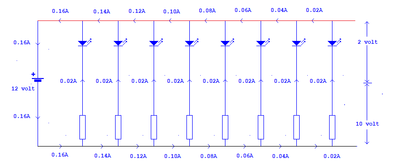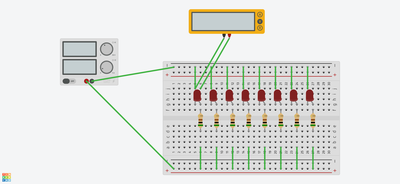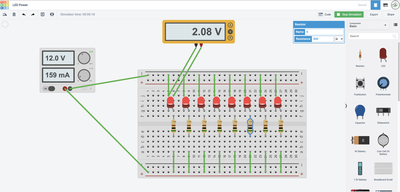I'm working on some Christmas gifts and could use some advice please. I would like to make a small string of LED lights in these 3d printed trees for my sister.
https://www.thingiverse.com/thing:193814/makes
These are the LED's that I would like to use and I would like to have 8 of them running in parallel so that I don't have to worry about one going out and killing the strand.
https://www.amazon.com/gp/product/B077X9Z3FW/ref=ox_sc_act_title_3?smid=A3S1JN3RP90N86&psc=1
From the information on the add for these LED's I can't figure out how much power to use if I run them in parallel. The top of the ad says they run from 6 - 12v but if you read the specs below it says they run on 3v? Could I please get some advice on what wall wort power supply I should buy for these?
Would something like this do the job? From the information listed in the ad, how would you add up the voltage draw and current to figure out what to purchase? I really don't like bothering you folks with these noob questions and have to learn to be more self sufficient when it comes to things like this.
Happy Holidays and as always, I really thank you for the help and kindness!
Gene
OK, so after reading the ad a few more times I can understand that when they say 6v - 12v they are saying this because the kit comes with the resistors to allow that voltage to be used in combo with the LEDs. The LED's run on 3v. So running the LED's in parallel would require more current correct? I could get away with a 5v power supply but would need more current. I'm reading that most LEDs of this size use up around 20ma so take 20ma and multiply that times 8 (the number of LEDs I want to run) and I get 160ma which is really not a lot. Am I on the right path to figuring this out or am I'm completely wrong here?
Seems like 12v power supplies are cheaper so I'm guessing a higher value resistor is in order.
The 3v you mention is the approximate voltage across the LED. The voltage across the resistor will be the supply voltage you use minus 3v and the resistor ohms will have to be this voltage divided by the LED current. This is a very rough and ready method of calculation and should only be used as a last resort; if the supplier has recommendations use them. LED's are very non linear devices so graphical methods of calculation are usually better. I did a writeup on this for another reply so I'll track it down and give you a reference.
Let me know if you have a problem opening it. I'm still fooling around with putting drawings into replies
The power supply voltage doesn't matter you choose LEDs to suit. In the example below the power supply would have to deliver 0.16 amps.
POWER (watt) = FORCE (volt) x CURRENT(amp)
= 12 * 0.16 = 1.92 watt
So let's say these LEDs require 20mA current and drop 2 volts between their terminals so we need the resister to drop 10 volts with a 12 volt supply.
R = E/I
Electric Resistance (ohm) = Electric Force(volt) / Intensity of Electric Current (amp)
R = 10 volt drop / 0.02 amp = 500 ohm
So for this circuit the Resister value required would be 500 ohm. You have to select the nearest value available say 470 or 570 ohms.
The voltage drop across a LED will vary.
20mA is standard for most RED YELLOW and GREEN LEDs requiring between 1.8 and 3.3 volts.
A BLUE LED will require 3 to 3.4 volt producing 30mA through the LED as will a WHITE LED.
To enlarge view of image right click mouse and select from the pop up menu "Open link in new window"
CORRECTION:
I wrote:
"The power supply voltage doesn't matter you choose LEDs to suit."
What I meant to write was:
The power supply voltage doesn't matter you choose resistors to suit the LED's requirements for any given voltage.
If only we could go back after one hour and correct silly mistakes.
Thank you all very much! Plenty of information for me to learn from here 🙂 So in the meantime here is what I needed up doing. I use TinkerCad for all my 3d printing designs. I also use it to learn how to make circuits. I created a circuit to match what I plan to build and tested out the voltage and resistor settings. TinkerCad does a nice job and showing me what could blow out the LEDs as well as just simply be too much voltage to put too much stress on the LED. I realize this is not the proper way to do this and I need to learn how to use the formulas but it at least got me going.
Looks like you have it all sorted now 🙂
Are you 3d printing the xmas trees. One thought is if the plastic is translucent you could use RGB (tricolor) LEDs for a nice dynamic color changing display.



